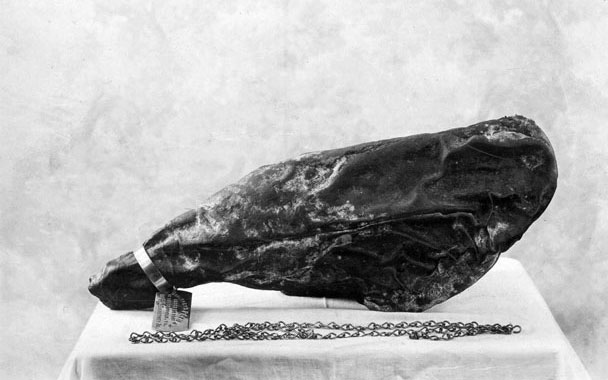When it comes to pets, we are defined by what we keep. Some of us are cat people. Others are dog people. (And ferret people, and guppy people, and gerbil people.) Lesser known are ham people, a cult whose mere existence makes potbellied pig people twitch and stammer.
Pembroke Decatur “P.D.” Gwaltney Jr. of Smithfield, Virginia, kept a pet ham.
Cured in 1902, his salted and smoked pig haunch should have been shipped to a customer that same year. Instead, it got lost in the shuffle and hung in the Gwaltney Company cure house until the 1920s, when P.D., who was evidently a student of P.T. Barnum, discovered the somewhat shriveled object of his affection.
P.D. had options, for, at that time, it was said to still be edible. He could declare his find to be vestigial American prosciutto and mete out slices to his best clients. He could, in the tradition of gifting the President with exceptional American products, ship that ham to the White House and hope the chef would see fit to serve it come Easter.
But P.D. had a grander idea. In a stunt intended to highlight the long-term storage potential of salted and smoked meat, he clamped an engraved brass collar and tag around the ham’s hock, insured it for $1,000 against fire and theft, and began traveling with his pet, showing it off at state fairs and expositions, pulling it from his suitcase so that admirers could gaze upon its goodness.
The stunt worked. Newspaper across the country reported of P.D.’s pet ham. And Ripley’s “Believe it or Not” believed the tale, writing it up at least three times, most recently in 2003, when the ham celebrated its centennial.
Now retired to a glass display case at the Isle of Wight Museum in Smithfield, his pet has, truth be told, lost a bit of its luster. The effects of salt and time, applied in the extreme, have rendered a ham that even a pet ham lover might not love.
If P.D.’s pet was singular, it might be written off to eccentricity. But I recently discovered that there are other hyper-aged American hams out there, the collective existence of which the collective existence of which suggests that pet hams sate some deep need.
Cured pork has long been a bedrock pantry item for rural Southern folk. A ham hanging in the smokehouse signified insurance against hard times. To cut into a ham in mid-winter, when food supplies dwindled and green goods were scarce, was to witness the beginning of the end—the end being, of course, starvation.
So it stands to reason that the instinct to keep rather than cut a ham has long been strong. Couple that with the knowledge that ham, like whiskey and wine, can improve with time, and you have all the rationale you need for (forgive me) salting one away.
The kept ham at the Mecca Restaurant in downtown Raleigh, North Carolina—a Greek-owned politico favorite, serving meat-and-threes—is a comparative babe. It dates to just 1937, the year that Nick Dombalis, grandfather of current owner Paul Dombalis, bought it from a farmer, in town for market, and put it in the front window for all to admire.
At the time, the Dombalis ham was 44 pounds, a real bruiser. In seven decades, it has shrunk to 25 pounds, despite stowage, since 1970, in the restaurant’s freezer. Nowadays, it reappears in the front window infrequently, usually when a longtime customer asks after it. When it does, the ham is only visible for a short while. (In May of 2007, when it last saw the light of day, the sign alongside read, “For security reasons, this will be a one-day viewing only.”)
Advocates of the P.D. Gwaltney ham might point out, rightly so, that, when it comes to country ham, climate-controlled storage is altogether unnecessary. Properly salted and smoked it should last until Kingdom Come. But Paul Dombalis doesn’t apologize for securing the future of a family heirloom, whose import was cemented during the Depression, when a country ham was a symbol of prosperity, worthy of display in a restaurant window.
“It’s an ugly thing,” the third generation owner recently told a newspaper reporter. “It’s just as ugly as it ever was.”
Parse those words and you recognize a mixture of resignation and pride. As in, He’s ugly but he’s ours, the same sort of sentiment expressed by pet owners who remain, beyond reason, beyond reckoning, devoted to cross-eyed cats and cur dogs and all manner of God’s irregular ranks.
Tasting Old Hams
Although I can’t recommend eating 100-year-old ham, or even 70-year-old ham, two-year-olds are worth pursuing. Here are two options:
At the Beaumont Inn, the pride of Bardstown, Kentucky, the Dedman family buys one-year-old hams from local producers. And they promptly hang them for one more year. Visit them and you’ll enjoy a breakfast platter piled high with the mellow goodness that an additional 12 months buys. www.beaumontinn.com
If you’re not able to make the Kentucky trek, dial up Nancy Newsom Mahaffey, proprietor of Colonel Bill Newsom’s Aged Country Hams in Princeton, Kentucky. She will, based upon availability, ship nitrate- and nitrite-free hams that are aged 18 months and sometimes more. www.newsomscountryham.com


